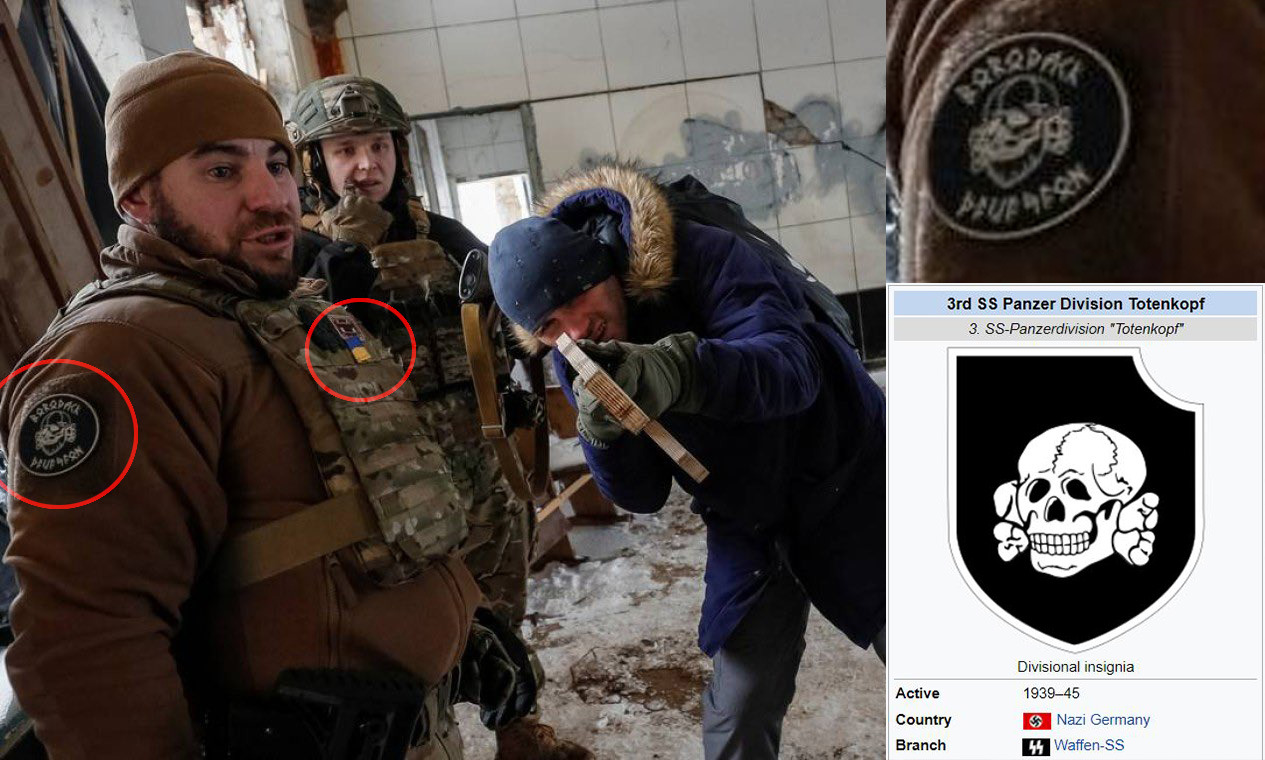
The New York Times reported on Monday (5), saying that “Nazi symbols on the front lines of Ukraine highlight thorny questions of history”.
“The use of insignia with Nazi emblems by troops risks fueling Russian propaganda and spreading images that the West has spent half a century trying to eliminate”, highlights the most influential newspaper in the USA.
Some excerpts*:
Since Russia began its invasion of Ukraine in 2022, the Ukrainian government and NATO allies have posted, then quietly deleted, three seemingly innocuous photos from their social media feeds: one soldier standing in a group, another resting in a trench and an emergency worker posing in front of a truck.
In each photograph, Ukrainians in uniform wore patches with symbols made notorious by Nazi Germany and have since become part of the iconography of far-right hate groups.
The photographs and their disappearance show the Ukrainian military’s complicated relationship with Nazi images, a relationship forged under German occupation during World War II. That relationship has become especially sensitive because Russian President Vladimir Putin considers Ukraine a Nazi state, a claim used to justify the invasion.
Ukraine has worked for years through legislation and military restructuring to curb a far-right fringe movement whose members proudly wear symbols steeped in Nazi history and espouse views hostile to leftists, LGBT people and ethnic minorities. But some members of these groups have been fighting Russia since the Kremlin annexed part of Crimea in 2014 and are now part of the broader military structure. Some are considered national heroes, even as the far right remains politically marginalized.
Iconography from these groups, including a skull and crossbones emblem worn by concentration camp guards and a symbol known as the Black Sun, now appear with some regularity on the uniforms of soldiers fighting on the front lines – the image is said to symbolize Ukrainian sovereignty and pride, not Nazism. (…)
“What concerns me, in this context, is that Ukrainian leaders are either unwilling or unwilling to acknowledge how these symbols are viewed outside Ukraine,” says Michael Colborne, a researcher at the Bellingcat group that studies the international far right. “Ukrainians need to realize that these images undermine support for the country.”
In a statement, the Ukrainian Ministry of Defense said that, as a country that suffered greatly under the German occupation, “we emphasize that Ukraine categorically condemns any manifestation of Nazism”. (…)
Even Jewish groups and anti-hate organizations that traditionally criticize hateful symbols have remained silent. Privately, some leaders fear being seen as supporting Russian propaganda arguments.
Questions about how to interpret these symbols are as contentious as they are persistent, and not just in Ukraine. In the American South, some insist that today the Confederate flag symbolizes pride, not its history of racism and secession. The swastika was an important Hindu symbol before it was co-opted by the Nazis.
In April, Ukraine’s Defense Ministry posted a photograph on its Twitter account of a soldier wearing a skull and crossbones emblem known as a Totenkopf, or Death’s Head. This symbol gained fame for a Nazi unit that committed war crimes and defended concentration camps during World War II. (…)

The Anti-Defamation League considers the Totenkopf “a common symbol of hatred”. But Jake Hyman, a spokesman for the group, said it was impossible to “make an inference about the Ukrainian army” in the patch. “The image, while offensive, is that of a musical band,” Hyman said. The band now uses the photograph posted by the Ukrainian military to market the Totenkopf patch.
The New York Times asked the Ukrainian Ministry of Defense on April 27 about the tweet. Hours later, the post was deleted. “After studying this case, we came to the conclusion that this logo can be interpreted ambiguously,” the ministry said in a statement. (…)
At least five other photos on the Lobos’ Instagram and Facebook pages show their soldiers wearing Nazi-style insignia, including the Totenkopf. The NATO military, which Ukraine hopes to join, does not tolerate such patches. When such symbols appeared, groups such as the Anti-Defamation League were critical and the NATO military reacted quickly. (…)
In March 2022, the NATO Twitter account posted a photo of a Ukrainian soldier wearing a similar emblem. Both photos were quickly deleted from the social network.
As early as November 2022, during a meeting with New York Times reporters near the front line, a Ukrainian press officer was using a variation of Totenkopf made by a company called R3ICH (pronounced “Reich”). He said he did not believe the patch was affiliated with the Nazis. A second press officer present said other journalists asked soldiers to remove the sticker before taking pictures. (…)
Some Ukrainians joined Nazi military units such as the Waffen-SS Galizien. The symbol of the group, led by German officers, was a sky blue emblem with a lion and three crowns. The unit participated in a massacre of hundreds of Polish civilians in 1944. In December, after a year-long legal battle, Ukraine’s highest court ruled that a research institute could consider the unit’s insignia as excluded from the banned Nazi symbols under a law of 2015. (…)
That makes it difficult to separate, on the basis of icons alone, Ukrainians enraged by the Russian invasion from those who support the country’s far-right groups. Units like the Da Vinci Wolves, the infamous Azov regiment, and other forces that started out as far-right members have been incorporated into the Ukrainian military and are instrumental in defending Ukraine from Russian troops. (…)
“I think some of these far-right units mix some of their own mythmaking into the public discourse about them,” says Colborne. “But I think the least that can and should be done everywhere, not just in Ukraine, is not to allow far-right symbols, rhetoric and ideas to infiltrate public discourse.”
*Translated by Charles Nisz
Source: https://www.diariodocentrodomundo.com.br/new-york-times-admite-que-tropas-da-ucrania-ostentam-simbolos-nazistas-imagens-minam-apoio/

